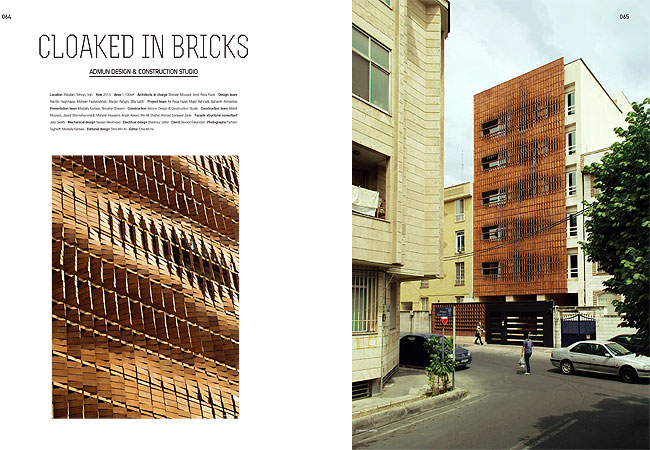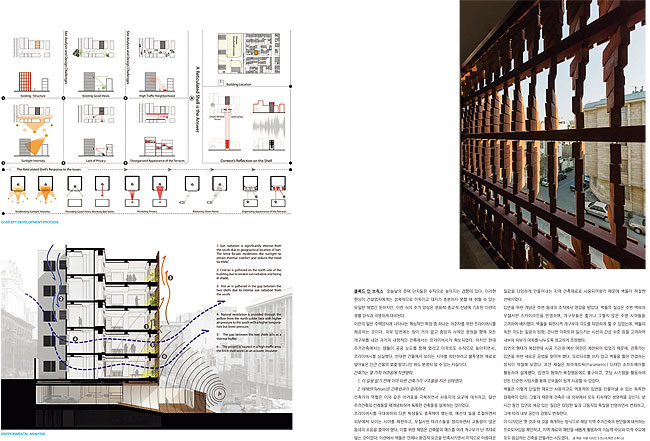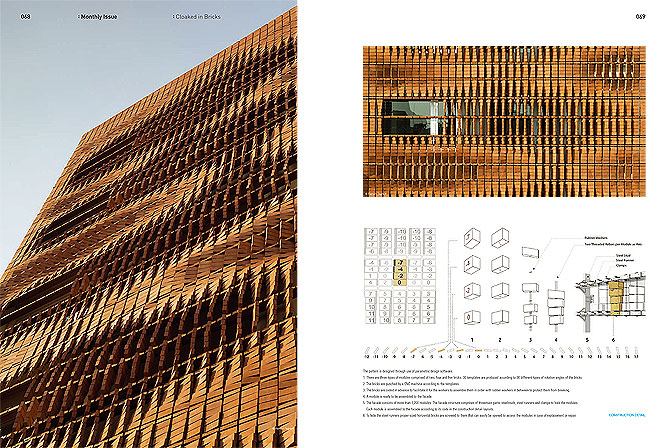Cloaked in Bricks
Admun Design & Construction Studio



클록드 인 브릭스 오늘날의 주택 단지들은 수직으로 높아지는 경향이 있다. 이러한 현상이 건설업자에게는 경제적으로 이득이고 대지가 충분하지 못할 때 취할 수 있는 유일한 해법인 듯하지만, 이런 식의 주거 양상은 문화적?종교적 신념에 기초한 이란의 생활 양식과 극명하게 대비된다.
이란의 일반 주택양식에 나타나는 핵심적인 특징 중 하나는 거주자를 위한 프라이버시를 제공하는 것이다. 외부 입면에는 창이 거의 없고 중앙의 사적인 정원을 향해 모든 개구부를 내던 과거의 내향적인 건축에서는 프라이버시가 확보되었다. 하지만 현대 주거건축에서는 창들이 공공 보도를 향해 열리고 아파트도 수직으로 높아지면서, 프라이버시를 상실했다. 반대편 건물에서 보이는 시야를 차단하려고 불투명한 재료로 덮어놓은 인근 건물의 몇몇 발코니만 봐도 분명히 알 수 있는 사실이다.
건축가는 몇 가지 어려움에 직면했다.
1. 이 일을 맡기 전에 이미 다른 건축가가 구조물을 지은 상태였다.
2. 테헤란(Tehran)은 건축법규가 엄격하다.
건축가의 역할은 이와 같은 어려움을 극복하면서 사용자의 요구에 대처하고, 일반 주거건축의 선례들을 재개념화하여 독특한 건축물을 설계하는 것이었다. 프라이버시를 극대화하되 다른 특징들도 충족해야 했는데, 예컨대 빛을 조절하면서 외부에서 보이는 시야를 제한하고, 무질서한 테라스들을 정리하면서 교통량이 많은 동네의 소음을 줄여야 했다. 이를 위한 해법은 건축물의 매스를 여러 개구부가 난 격자로 덮는 것이었다. 이란에서 벽돌은 언제나 환경적 요건을 만족시키면서 미적으로 아름다운 질감을 다양하게 만들어내는 지역 건축재료로 사용되어왔기 때문에 벽돌이 적절한 선택이었다. 입면을 위한 개념은 주변 동네의 조직에서 영감을 받았다. 벽돌의 질감은 주변 맥락의 무질서한 스카이라인을 반영하며, 개구부들은 좋거나 그렇지 않은 주변 시야들을 고려하여 배치했다. 벽돌을 회전시켜 개구부의 각도를 다양하게 할 수 있었는데, 벽돌의 회전 각도는 일광의 방향, 건너편 아파트와 일으키는 시선의 간섭 수준 등을 고려하여 내부와 외부가 대화를 나누도록 정교하게 조정했다.
입면의 형태가 복잡한데 시공 기간과 예산 여건은 제한되어 있었기 때문에, 건축가는 입면을 위한 새로운 공법을 찾아야 했다. 모르타르를 쓰지 않고 벽돌을 뚫어 연결하는 방식이 적절해 보였다. 표면 재질은 파라메트릭(Parametric) 디자인 소프트웨어를 활용하여 설계했다. 입면의 형태가 복잡했음에도 불구하고, 코딩 시스템을 활용하여 만든 단순한 시방서를 통해 인부들이 쉽게 시공할 수 있었다.
벽돌은 이렇게 단일한 재료만 사용하고도 역동적인 입면을 만들어낼 수 있는 독특한 잠재력이 있다. 그렇기 때문에 건축은 내?외부에서 모두 지속적인 생명력을 갖는다. 낮 시간 동안 입면의 색감 있는 질감은 다양한 빛과 그림자의 특질을 반영하면서 변화하고, 그에 따라 내부 공간의 경험도 변화한다.
이 디자인은 옛 것과 새 것을 매개하는 방식으로 해당 지역 주거건축의 현안들에 대처하는 프로토타입을 제안하고, 지역 재료와 패턴을 새롭게 활용하여 기능적 수요와 미적 수요에 모두 응답하는 건축을 만들려는 시도였다.
글 제공: 아문 디자인 & 컨스트럭션 스튜디오
The current housing developments tend toward a vertical growth and even though this pattern of housing is economically profitable for the builders and seems to be the only solution to the lack of sufficient land, it is extremely in contrast with Iranian lifestyle originating from their cultural and religious belief. A key characteristic of Iranian vernacular residential architecture was providing privacy for the residents which in the past was achieved through an introverted architecture often formed around a central private garden with all the openings oriented to that and the windows were rarely exposed on the outer faces. However, in the contemporary residential architecture windows are opened to the public passage and with the vertical growth of the apartments, privacy has become a lost quality. An evidence of this claim is several balconies in the neighborhood covered by opaque materials blocking view from the opposite buildings.
The design team faced several challenges:
1. The structure was constructed by another team before we were commissioned the job.
2. The strict building codes in Tehran.
The architect’s role was to overcome the mentioned challenges to produce a design that addresses its users’ needs and reconceptualize vernacular precedents to create a unique architecture.
To provide maximum privacy yet fulfilling other features such as moderating light, limiting view from outside, organizing chaotic experience of the terraces and decreasing high-traffic neighborhood noise, the solution seemed to be covering the architectural mass in a grid of openings. Brick appeared to be a proper choice since it has always been used as a local building material in Iran meeting environmental needs while creating numerous aesthetically beautiful textures. The concept for the facade is inspired from the surrounding neighborhood fabric. The brick texture is a reflection of the context’s chaotic skyline and the openings are located considering the pleasant and unpleasant neighborhood views.
Rotating the bricks provided the opportunity to have various degrees of opening sand the rotation angles are precisely adjusted through a dialogue between inside and outside considering sun direction, daylight and level of distraction from the across apartments. The complex form of the facade, limited construction period and economical conditions of the project forced the project team to search for a new construction method for implementing the facade. The appropriate method seemed to be eliminating mortar by punching the bricks. Parametric design software facilitated the texture design process. Despite the complex form of the facade the construction process was easily executable by workers through simple instructions prepared by employing a system of coding.
Brick has this unique potential to create a dynamic facade while using merely a single material. The architecture is constantly alive, from both inside and outside. The facade’s colorful texture changes during the day representing different qualities of light and shadow as the inner spaces experience the same. The design was an attempt to propose a prototype addressing the current issues of residential architecture in its region through bridging between old and new, proving how local materials and patterns can be used in new ways creating an architecture responding to both functional and aesthetic needs.
Text offer: Admun Design & Construction Studio
건축문화 2016년 9월호 [Monthly Issue]페이지 © 에이엔씨출판(주)